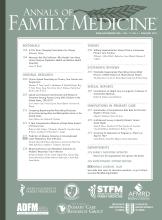Abstract
PURPOSE Technology could transform routine decision making by anticipating patients’ information needs, assessing where patients are with decisions and preferences, personalizing educational experiences, facilitating patient-clinician information exchange, and supporting follow-up. This study evaluated whether patients and clinicians will use such a decision module and its impact on care, using 3 cancer screening decisions as test cases.
METHODS Twelve practices with 55,453 patients using a patient portal participated in this prospective observational cohort study. Participation was open to patients who might face a cancer screening decision: women aged 40 to 49 who had not had a mammogram in 2 years, men aged 55 to 69 who had not had a prostate-specific antigen test in 2 years, and adults aged 50 to 74 overdue for colorectal cancer screening. Data sources included module responses, electronic health record data, and a postencounter survey.
RESULTS In 1 year, one-fifth of the portal users (11,458 patients) faced a potential cancer screening decision. Among these patients, 20.6% started and 7.9% completed the decision module. Fully 47.2% of module completers shared responses with their clinician. After their next office visit, 57.8% of those surveyed thought their clinician had seen their responses, and many reported the module made their appointment more productive (40.7%), helped engage them in the decision (47.7%), broadened their knowledge (48.1%), and improved communication (37.5%).
CONCLUSIONS Many patients face decisions that can be anticipated and proactively facilitated through technology. Although use of technology has the potential to make visits more efficient and effective, cultural, workflow, and technical changes are needed before it could be widely disseminated.
- health information technology
- screening
- decision making
- computer-assisted
- patient education
- primary care
- practice-based research
- Received for publication September 18, 2016.
- Revision received December 22, 2016.
- Accepted for publication December 31, 2016.
- © 2017 Annals of Family Medicine, Inc.







